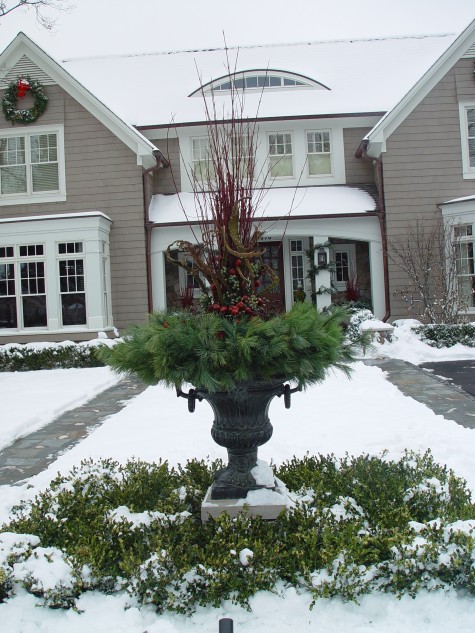
An evergreen is nature’s equivalent of an engineering miracle. Evergreen needles are long, narrow, thick and waxy; their shape evolved specifically in response to one thing-the conservation of moisture. Evergreens cannot take up water once all the available water in the soil freezes. The needles thus have a minimum amount of surface area from which moisture can evaporate; such is how they stay green all winter. Even when cut, the needles stay green a long time. Trees cut in August destined to be Christmas trees are still green in December, though they are beginning to dry. Cut greens play a crucial role in our winter displays. White pine has a gracefully informal look. We stuff our forms with the branches curved side up, as they are pliable in stem, and soft in needle. The very sculptural centerpiece in this urn rests on its pillow of white pine.
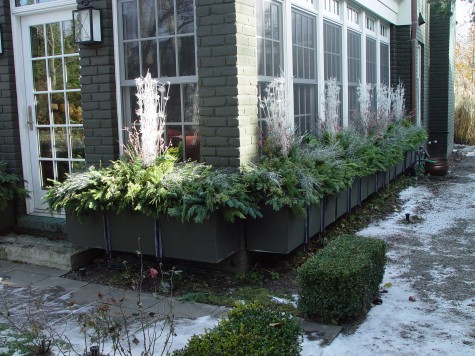 Mixing greens makes it possible to hedge your bet. Cut evergreens are best in cold temperatures; the cold further slows the rate of water evaporation. Though all the cedar species have attractive flat scaly needles, they are the first to dessicate if the late fall takes a warm turn. Their loss of color from evaporation is less noticeable when they have more lively companionship. Mixed greens add textural interest interest in volume. This mix of Douglas fir, white pine, cedar and silver fir illustrates clearly how variable a natural green color can be.
Mixing greens makes it possible to hedge your bet. Cut evergreens are best in cold temperatures; the cold further slows the rate of water evaporation. Though all the cedar species have attractive flat scaly needles, they are the first to dessicate if the late fall takes a warm turn. Their loss of color from evaporation is less noticeable when they have more lively companionship. Mixed greens add textural interest interest in volume. This mix of Douglas fir, white pine, cedar and silver fir illustrates clearly how variable a natural green color can be.
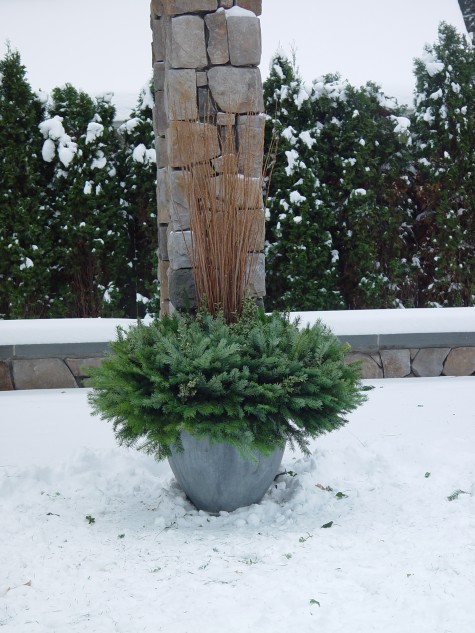 Fir species are instantly identifiable. The needles are arranged in the half round; the branches are flat on their undersides. Douglas fir is one of my favorite evrgreen plants. They will tolerate a little shade, and they are very disease and insect resistant. They are commonly available as Christmas trees; their soft needles make trimming a tree easy on the hands. As cut branches, they are remarkably long lasting. Their bright medium green makes them a good choice for arrangements viewed from far away. It is not unusual for me to clean out winter pots in April where the Douglas fir branches are still green.
Fir species are instantly identifiable. The needles are arranged in the half round; the branches are flat on their undersides. Douglas fir is one of my favorite evrgreen plants. They will tolerate a little shade, and they are very disease and insect resistant. They are commonly available as Christmas trees; their soft needles make trimming a tree easy on the hands. As cut branches, they are remarkably long lasting. Their bright medium green makes them a good choice for arrangements viewed from far away. It is not unusual for me to clean out winter pots in April where the Douglas fir branches are still green.
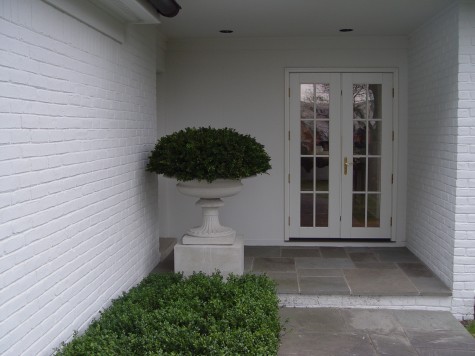
Cut boxwood is a great choice for more formal arrangements. As boxwood is a broad leaf evergreen, I wiltpruf the cut stems after I arrange them. This liquid waxy emulsion helps to further slow the loss of water from the leaves. Milky when applied, it dries clear. Research has shown that late fall plantings of boxwood, yews and evergreen trees benefit greatly from a treatment of wiltpruf.
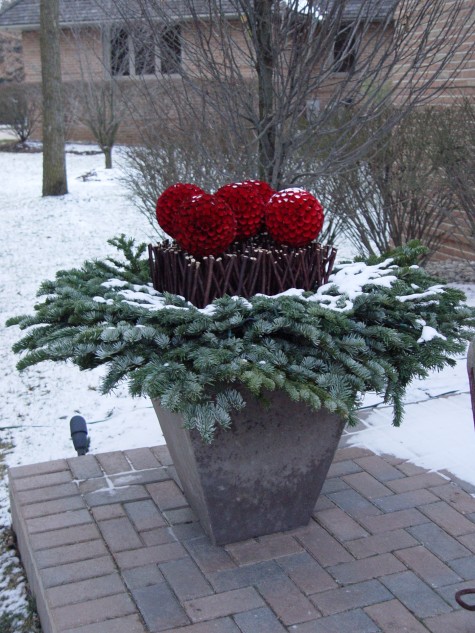 Silver fir branches are an icy blue color; it is all the more attractive paired with red. These spheres are made from giant wood shavings that are dyed red. The color is remarkable stable outdoors; there is little in the way of fading even in full sun. We test any materials we think might go outdoors, to be sure they can withstand wet weather.
Silver fir branches are an icy blue color; it is all the more attractive paired with red. These spheres are made from giant wood shavings that are dyed red. The color is remarkable stable outdoors; there is little in the way of fading even in full sun. We test any materials we think might go outdoors, to be sure they can withstand wet weather.
 Berried juniper, and noble fir contrast in texture, and compliment one another in color. Natural eucalyptus pods are quite blue, and weather to a soft grey. Chocolate and cream ting stacks complete the ensemble.
Berried juniper, and noble fir contrast in texture, and compliment one another in color. Natural eucalyptus pods are quite blue, and weather to a soft grey. Chocolate and cream ting stacks complete the ensemble.
 This dried mood moss is soaked with a spray of moss dye before it goes outdoors. In full sun, this treatment may need to be repeated during the course of the season. The wood dowel trunk of this winter topiary is covered in mountain reed of a color similar to the rusty age on these vintage English painted steel boxes. The top of the box is stuffed with a variegated boxwood known in the florist’s trade as oregonia.
This dried mood moss is soaked with a spray of moss dye before it goes outdoors. In full sun, this treatment may need to be repeated during the course of the season. The wood dowel trunk of this winter topiary is covered in mountain reed of a color similar to the rusty age on these vintage English painted steel boxes. The top of the box is stuffed with a variegated boxwood known in the florist’s trade as oregonia.
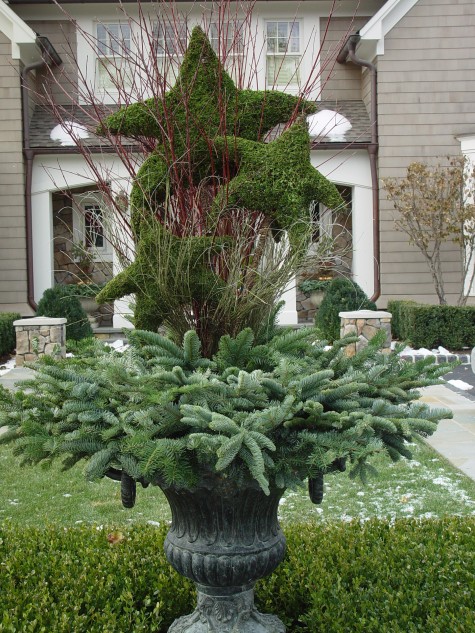
No matter which form or color of evergreen appeals to you, they all perform a great service during our winter months-in or out of the ground.
I needed this post! I needed these ideas! Thank you, thank you, thank you!